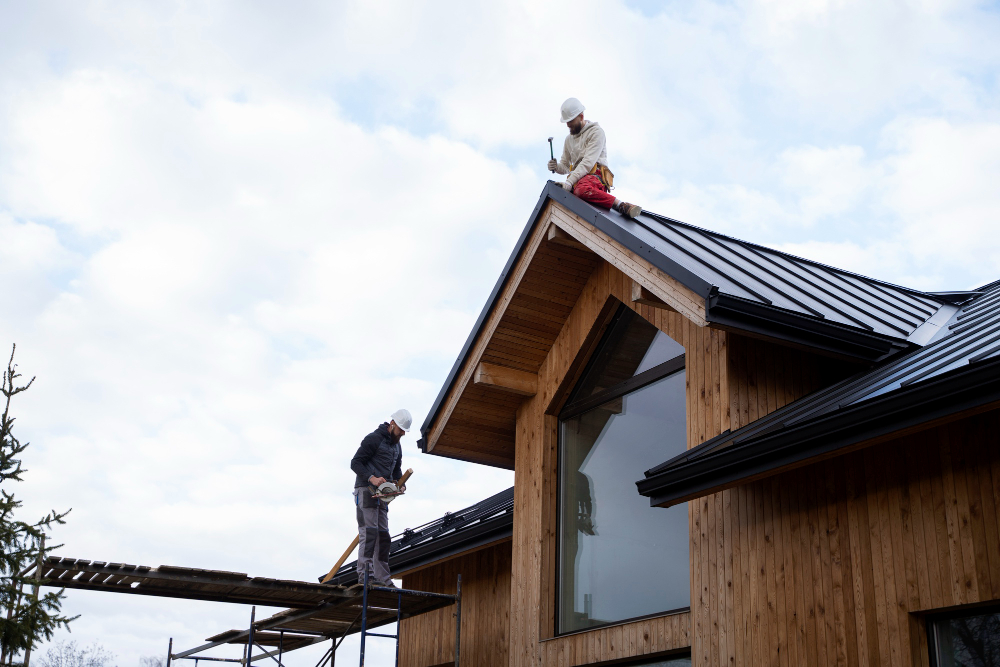Commercial roofs—TPO, PVC, EPDM, built‑up, modified bitumen, and metal—protect people, inventory, and operations. A disciplined maintenance program lowers leak risk, extends service life by years, and reduces lifecycle cost per square foot. This guide outlines five best practices your facility team can implement immediately, plus checklists, PM cadence, and documentation tips to satisfy insurers and warranty conditions.
Safety first: Follow OSHA fall‑protection rules, use designated tie‑offs, and keep a spotter on the ground when moving materials. Never work during lightning, high winds, or icy conditions.
Best Practice 1: Standardize Inspections (Spring & Fall + Post‑Storm)
What to do
- Perform semiannual inspections (spring/fall) and after hail, wind, or heavy rain.
- Use a consistent route: access → perimeter → field membrane → penetrations → drainage → equipment curbs → parapets → terminations.
- Photograph each elevation and detail; repeat from the same vantage points each visit to detect change.
What to look for
- Membrane: punctures, splits, blisters, open seams, scuffs at walk paths.
- Flashings & terminations: loose counter‑flashings, open laps, failed sealant, loose termination bars.
- Penetrations: cracked pipe boots, deformed pitch pans, gaps at skylights, antennas, or RTU curbs.
- Drainage: ponding water (>48 hours), clogged drains, crushed strainers, back‑pitched gutters.
- Edge metal/parapets: fastener back‑out, rust, displaced coping.
- Accessories: expansion joints torn, lightning protection loose, loose pavers.
Deliverable
- Complete an inspection checklist with photos, annotate roof plan with defect locations, and assign priority (Emergency/30‑Day/Quarterly/Monitor).
Best Practice 2: Keep Water Moving (Drains, Gutters, Scuppers)
Why it matters Standing water accelerates membrane aging, adds structural load, attracts debris, and finds weak points. Most leaks start with poor drainage.
Actions
- Quarterly cleaning of primary and secondary (overflow) drains; remove organic debris and check that domes/strain ers are secured.
- Verify positive slope to drains; mark chronic ponding areas on the roof plan.
- Flush downspouts with a hose; snake if slow.
- Inspect scuppers and conductor heads for seam failures and bird nests.
- Confirm downspouts discharge 4–6 ft from the foundation or into code‑approved storm systems.
Quick checks
- After a rain, walk the roof within 24–48 hours; photograph any water lingering near drains or behind HVAC curbs.
- Ensure ballast pavers or mats aren’t blocking flow paths.
Best Practice 3: Protect Vulnerable Details (Flashings, Penetrations, Edges)
Focus areas
- HVAC/RTU curbs: inspect corners where motion concentrates; reseal loose counter‑flashing and add pitch pan filler as needed.
- Parapet & edge metal: confirm cleat engagement, replace stripped fasteners with oversized stainless, and seal laps.
- Skylights: check lenses for crazing/cracks and curb membranes for fishmouths; test weep holes.
- Pipe boots: replace cracked neoprene; ensure clamping bands are tight but not deforming the boot.
- Wall transitions/expansion joints: repair tears and re‑secure termination bars with butyl tape + sealant per manufacturer.
Preventive upgrades
- Add walk pads along service routes to HVAC and ladders.
- Install corner reinforcement patches at stress points.
- Use sacrificial protection sheets under antennas or around frequently serviced equipment.
- For metal roofs, torque‑check fasteners, replace failed washers, and seal end laps; consider snow retention in northern climates.
Best Practice 4: Control Rooftop Traffic & Housekeeping
Rules
- Post a Roof Access Policy: log all entries; require walk‑pads; prohibit dragging tools.
- Allow only trained vendors; require them to sign that they’ll report any damage before leaving.
- Keep a clean deck: remove shipping pallets, wire clippings, sheet‑metal scraps, and broken pavers after each service visit.
- Store materials on protective dunnage; never concentrate loads over weak decking or near skylights.
Common hazards to remove
- Loose screws/fasteners (membrane puncture risk)
- Abandoned conduit or cable ties with sharp edges
- Organic debris accumulating at corners and behind curbs
Signage & barriers
- Label skylights and fragile surfaces; use guardrails/cages as needed.
- Paint high‑visibility paths to drains and mechanicals.
Best Practice 5: Document, Budget, and Comply (Warranty + OSHA)
Documentation set
- Roof plan with zones, drains, and penetrations numbered.
- Photo log (date‑stamped) for each inspection and repair.
- Leak log with source, weather, location, corrective action, and time to close.
- Vendor list with insurance, contacts, and scope history.
Budgeting
- Separate OPEX (cleaning, inspections, minor repairs) from CAPEX (re‑cover, replacement, major upgrades).
- Forecast 3–5 years for overlays, coating cycles, or replacement based on condition index.
- Track cost per square foot per year; aim to reduce reactive leak calls.
Warranty & code
- Follow manufacturer maintenance requirements (cleaning schedule, compatible sealants/adhesives).
- Keep records to preserve warranty claims.
- Maintain OSHA compliance: fall protection, ladder safety, and electrical clearances around RTUs.
PM Cadence: Sample Annual Schedule
| Month/Season | Task |
| January–February | Limited access; check for ice dams and interior leaks; review leak log |
| March | Spring inspection; clear drains/gutters; repair winter damage |
| May–June | Edge metal/curb detail tune‑up; add walk pads before cooling season service |
| August | Drain cleaning; mid‑season housekeeping; verify RTU condensate lines |
| October | Fall inspection; sealants; expansion joint & flashing checks |
| December | Year‑end photo survey; budget and capital plan for next year |
Conclusion
By standardizing inspections, keeping water moving, reinforcing vulnerable details, controlling rooftop traffic, and documenting everything, you’ll extend roof life, reduce emergency calls, and protect your budget. Adopt these five practices, attach the checklist to your PM program, and make every service visit leave the roof better than you found it.
Need this as a printable PM checklist or a vendor sign‑in form? I can convert this guide to a one‑page PDF and add your company logo and site details.
FAQs
How often should a commercial roof be inspected?
At least twice a year—spring and fall—and after severe weather.
What’s an acceptable ponding duration?
Ideally none. Water should drain within 24–48 hours. Chronic areas need slope correction or auxiliary drains.
Are coatings a substitute for repairs?
No. Address defects first; use coatings as part of a restoration system when the substrate is sound.
Who should access the roof?
Only trained personnel or vendors who sign in, follow your access policy, and document conditions before/after work.
How do I preserve my warranty?
Follow the manufacturer’s maintenance guide, keep dated records, and use approved materials/components for repairs.


